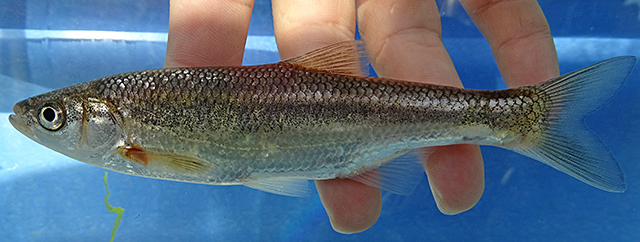| Leuciscidae (Minnows), subfamily: Leuciscinae |
| 12.2 cm SL (male/unsexed); 11.72 cm SL (female) |
|
benthopelagic; freshwater |
| Asia: Iran. |
|
This species is distinguished from all its congeners in Iran and the wider Euphrates and Tigris drainage by the following characters, none of which are unique: superficially similar to A. atropatenae (from the endorheic Lake Urmia basin) but differs by having usually (12) 13-17 (18) gill rakers on the first branchial arch (vs. usually (10) 11-13 (15)); both A. doriae and A. atropatenae have a mid-lateral stripe between the head and the caudal-fin base, but in A. doriae, this stripe is diluted with hazy borders anterior to the dorsal-fin base (vs. with sharp borders along all its length); differs from A. filippii from the Caspian Sea basin by having usually 8½ branched dorsal-fin ray (vs. 7½) and the ventral keel between the pelvic-fin base and the anus fully covered by scales (vs. ventral keel entirely naked or naked part extends more than 50% of the distance between the pelvic-fin origin and the anus); differs from A. hohenackeri (from the Caspian Sea basin in being invasive in the Tigris drainage) by having fewer gill rakers 12-18 (vs. 18-25) and branched anal-fin rays 9-12½, mode 11½ (vs. 12-16½, mode 13½); differs from A. caeruleus (from the Qweik, Euphrates and Tigris drainages) by having fewer branched anal-fin rays 9-12½ (vs. 13-18½), more gill rakers on the first gill arch 12-18, usually 14-15 (vs. 9-13) and a more slender body, body depth at dorsal-fin origin 20-25% (vs. 26-31% SL); differs from A. sellal (from the Qweik, Euphrates and Tigris drainages) and A. zagrosensis (from headwaters of the Karun River) by having fewer scales along the lateral line 44-56 (vs. 62-86 in A. sellal and 67-83 in A. zagrosensis), fewer scale rows between the dorsal-fin origin and the lateral line 8-12 (vs. 12-19 in A. sellal and 13-15 in A. zagrosensis) and fewer scale rows between the lateral line and the pelvic-fin origin 2-5 (vs. 4-7 in A. sellal and A. zagrosensis); differs from A. heckeli (from Lake Hazar in Turkey) by having fewer lateral-line scales 44-56 (vs. 82-93), fewer gill rakers 12-18 (vs. 19-26) and fewer branched anal-fin rays 9-12½, usually 10-11½ (vs. 12-14½, usually 13½); differs from A. tarichi (from Lake Van in Turkey) by having fewer gill rakers 12-18 (vs. 21-29); differs from A. timarensis (from the Lake Van basin) by having fewer lateral-line scales 44-56 (vs. usually 54-65); differs from A. selcuklui (from the upper Tigris) by having fewer lateral-line scales (44-56 vs. 70-80), scales between lateral line and dorsal-fin origin 8-12 (vs. 13-18) and scales between the lateral line and the pelvic-fin origin 2-5, mode 4 (vs. 5-7, mode 6) (Ref. 116542). |
| Construction of the dam on the Zayandeh River (where it is known as Petroleuciscus esfahani) has altered the ecology of the river system. However, its effects on the distribution and numbers of the new species is unknown. It may be relatively secure in higher tributary streams but demands on water resources from this and other rivers on the central desert plateau of Iran have increased markedly as the human population of the country has doubled in 30 years. Freshwater resources are under threat, exacerbated by droughts, and all species found in these desert or semi-desert areas are under stress (Ref. 84539), |
|
Not Evaluated (N.E.) Ref. (130435)
|
| harmless |
Source and more info: www.fishbase.org. For personal, classroom, and other internal use only. Not for publication.
